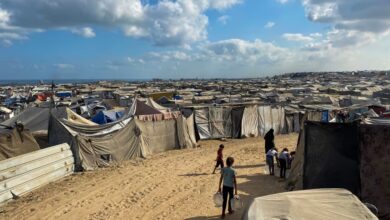
Ramallah has a shining international image: it has restaurants, nightclubs, culture, fun. In Joe Sacco’s pioneering graphic novel “Palestine,” all the “hepcat Arabs” are from Ramallah. But where did Ramallah come from?
In the newly released book “In Ramallah, Running,” contributor Najwan Darwish writes that, in the 1920s, Ramallah was a village; in the 1950s and 1960s, it was a summer destination; and in the 1970s and 1980s, refugees made it a city.
And then suddenly, in the second half of the 1990s, post-Oslo, Ramallah became the capital of Palestinian self-rule, in a partial attempt to draw Palestinians away from Jerusalem.
Ramallah is thus a city that is cobbled together from many political interests, where, Darwish writes, “new kinds of NGOs sprung up like mushrooms.” It is also — because this is occupied Palestine — a city where many places are unmapped.
So London-based writer-activist Guy Mannes-Abbott decided to run around the city, to get a vantage point, and to find out where the limits are.
Egypt Independent: Many readers’ impressions of Ramallah have been formed by Mourid Barghouti’s lovely “I Saw Ramallah,” and Raja Shehadeh’s “Palestinian Walks,” which your book, in some ways, challenges. Are there any other books or poems that inspired you?
Guy Mannes-Abbott: Yes, those are the most concrete voices, albeit with rather different weights in my writing. Other books and poems form more of a lifetime’s “mist,” but include Mahmoud Darwish of course. … But the hills and valleys hum with words about the impossibility and potential of “existing” anyway.
Adania Shibli sent me stories years ago, quietly articulating the preyed-upon interiors of her narrators. There’s also much art and film foregrounding the occupation. I wanted to do something else, to try to engage with the place itself, beyond the familiar abstractions of occupied space.
EI: How did the “In Ramallah, Running” project begin? Did you start running [in Ramallah] first, or want to write about Ramallah, and so ran?
Mannes-Abbott: It began with a very long-held aspiration to visit and so write about Palestine. … I’m far from being a lifetime runner but had begun running regularly before going to Ramallah and that folded into a primary desire to write about the place. What running did was to habituate me to intimate elements of the city quickly, throwing up people and taking me places I would not have encountered otherwise — road builders, patrolling soldiers, parents on school runs, families on dusky stoops.
EI: Barghouti’s “I Saw Ramallah” creates space for the reader who is unsympathetic to Palestinians: It is strongly self-critical. Your book seems to spend less time on that, and is more straightforward about what you find criminal.
Mannes-Abbott: Clearly it’s not my place and there are criticisms I won’t indulge. Essentially this is an open-air prison camp and such places generate cultures that are not perfect. So I tread firmly but approach at an angle, for instance when describing overlaps between Palestinian Authority development and Israeli settlement infrastructure.
In terms of readers, I know that very few can know what they will discover in the book. Few English-speaking readers encounter much about Palestinians’ right to exist, the interiors of the place or people there. I’m well aware how partisan the book will seem in the English-speaking world and am unapologetic; it was essential to write without trapping myself in tedious justifications or the dominant narrative.
Even so, in the first readings I’ve given it’s surprised me just how evidently moved audiences have been and the responsibility it brings.
An exclusive extract from Guy Mannes-Abbott’s new book, "In Ramallah, Running"
A road at the top reveals the settlement surrounded by security infrastructure fit for a small airport. Neat suburban houses crowd the easterly slope, above a classic two-way security gate and a homely ramp for tank access. Only a few years ago, Ramallah was reinvaded by 150 tanks and APCs, an unimaginable thought. Ahead is only trouble. As I walk slowly towards it I realize that the hill I was hoping to find now looms to my left. Alluringly bare, it wears a meandering pathway on its far edge, the beginning of which is opposite the settlement’s gates. I step calmly over and keep walking on up the hill without glancing back or taking a breath. I’ve got to try it.
I climb steadily but cannot shake a sickening degree of anxiety which is also fitting given what I know to be true. It’s only days since nine people were killed on the Mavi Marmara (part of an aid flotilla for Gaza in International waters), forcing on the world a glimpse of everyday reality here inside the Occupation. I know the well-documented history of shootings and massacres, the bottomless impunity of soldiers and settlers. Settlers who are watching, perhaps readying to shoot me now as I walk up a hill that I’m forbidden to approach. I feel exceedingly exposed to their mercy; a very strange sensation. I step to the highest point of the track, hoping they might have the decency to shoot me in the legs. Realise they don’t but that — like so many children, passers-by, protesters before me — I will not hear the explosion in my head. Then that I’d miss my new-found runner’s legs; it wouldn’t be worth it.
I am not being heroic, not exaggerating or debunking. I’ve looked down the barrel of many an automatic, been caught-up in no-man’s-land on many warring borders, feared for my life in Honduran fields, witnessed state sponsored massacres in Gujarat, India, but even these things are exceptions and retained some legibility. Here it happens all the time, every day and for decades on end. If they fancy shooting me in the head, they will. There is no way to calibrate the risk involved in continuing to walk here on the hill, or imagine what the back of my head looks like to a mad gunman on a stolen hill. It makes for a unique anxiety and matching relief when I reach the far side of the hilltop out of sight of the settlement. It’s a matter of being able to breathe again.
Copyright Guy Mannes-Abbott
EI: How much was this an “artistic” project versus a “political” one?
Mannes-Abbott: My writing must stand or fall by literary or artistic standards. The politics come in the act of writing the book and certainly the project as a whole is necessarily political. However, the artists’ contributions were also treated and judged on artistic merits, partly because a related political infusion and maturity was assumed.
Yet notice how they all respond to what Mourid Barghouti describes as the “cunning simplicity” of my texts by deepening the ambiguities.
EI: Why did you decide to include other materials beyond your own, both the visuals and Emily Jacir’s diary fragments, Adania Shibli’s novel excerpt and Najwan Darwish’s essay?
Mannes-Abbott: I conceived the project as a collaborative one. Once I completed the texts, I met with Samar Martha of Art School Palestine to discuss it and we came up with an almost identical shortlist of artists to invite.
They had to be artists of note with a relationship with Palestine. They had only my texts to respond to and knew the book would be at least half full of those texts. Shibli and Darwish responded in Arabic and can and do say interior things I can’t and don’t attempt in my writing. Jacir’s piece can be taken as a rebuke to my writing about this place and as a trusting collaboration with my texts.
My texts have rhythmic demands as a series, but anyway, none of the artists took up my invitation to intervene and we wanted to treat the art quite soberly — let it be what it is and not “play” around with it visually. The exception is Paul Noble’s drawings, which he specifically wanted to almost hide in my texts.
EI: Why did you decide not to intersperse any photographs of Ramallah or other things you discuss?
Mannes-Abbott: I took hundreds of photographs — including of settlements — but my words have to conjure images and persuade readers to bring their imaginations to the places they “sketch.” I think we know that settlements look like militarized US suburbs! But the point was to “show” what Palestine looks like beyond them! Also, I wanted to respect artists’ contributions which I knew were likely to be photographic in part. So the images of mine needed to retain a certain humility.
EI: You don’t write much about yourself, besides walking and running around the environs of Ramallah. Why did you choose to mostly leave yourself out of the project?
Mannes-Abbott: I was trying to let the place speak itself, if that doesn’t sound faux-naive. I’m aware of obvious colonial legacies and practices and that I’m going and “recording” the place too! So motivation, method and a certain exactitude are crucial, no? That’s why I tried so hard to maintain this “outsiderness” in the writing. I did and do have close friends in and from Palestine, but when I arrived I just started walking, running, stumbling on my own, and for me that was essential. What I’ve written is true to that experience.
EI: At times, this also reminded me of Suad Amiry’s “Nothing to Lose But Your Life,” in its purposeful transgression of borders. Do you think the physical act of transgressing limits was an important part of the narrative act of also transgressing limits?
Mannes-Abbott: Yes, I think it was crucial, though I really don’t want to appear heroic! I did some things which I would not do again but felt I had to try. I’ve taken calculated risks elsewhere; riding in disguise, sleeping in caves and on roofs between troops and dug-in positions around the Rann of Kutch during India and Pakistan’s nuclear standoff a few years ago, which was quite exciting.
The crucial difference here was Israeli impunity; it’s impossible to calibrate the risks. Beyond that, the form of the writing is transgressive, or anyway, breeches formal categories to obtain something resistant.
This piece was originally published in Egypt Independent's weekly print edition.




